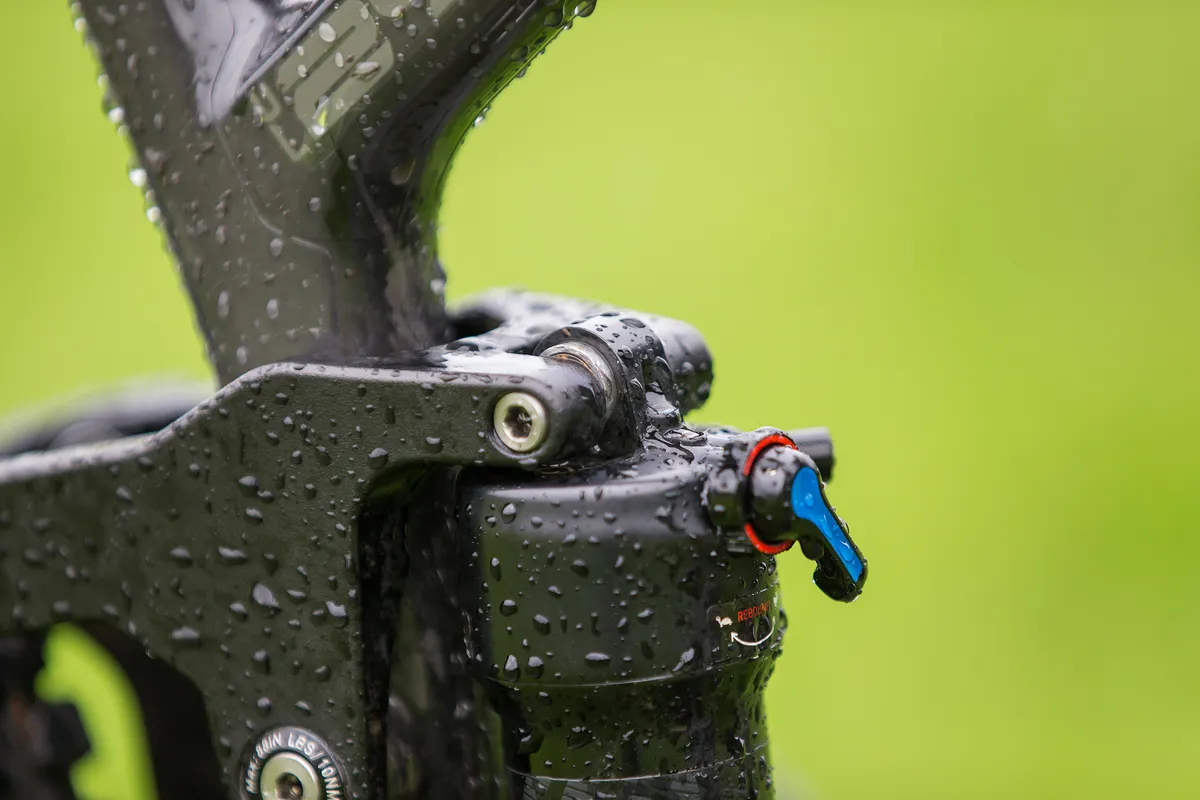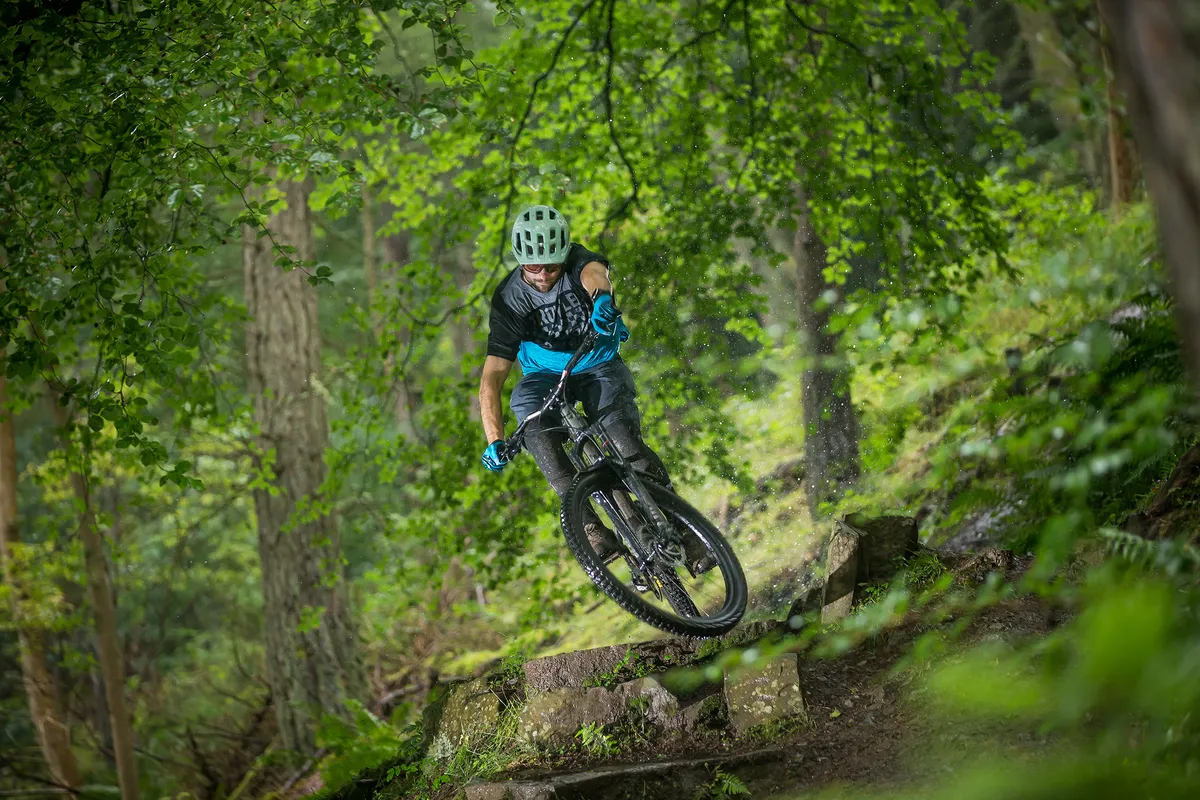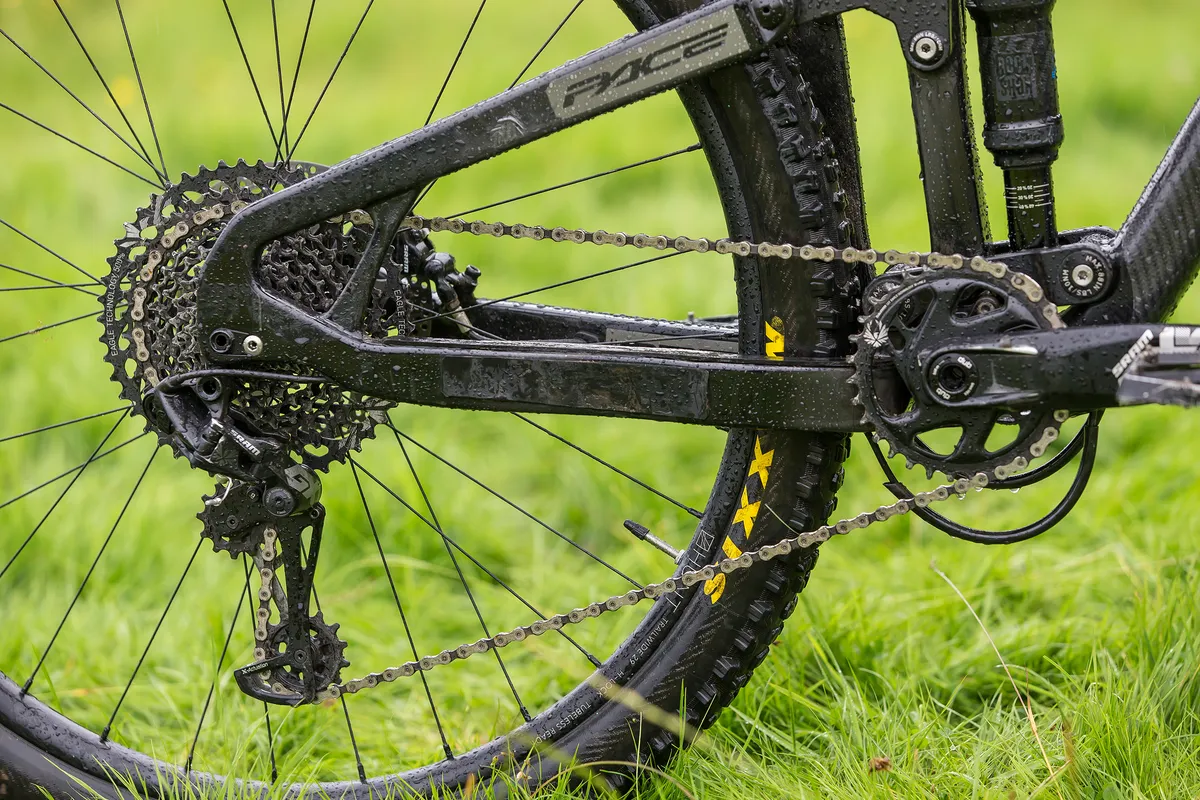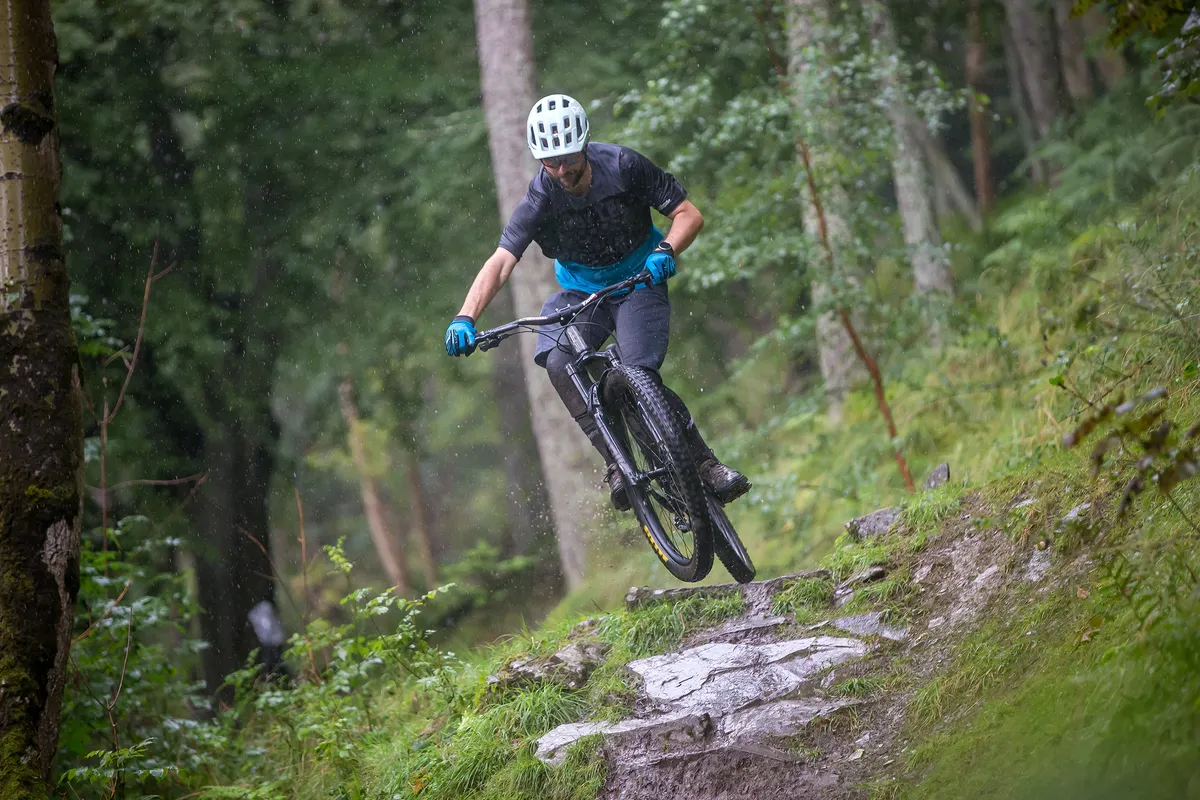If you’re old enough to remember Pace’s early years you will no doubt have dreamed one day of owning its square-tubed RC100 hardtail with a carbon fibre fork and rear-face front brake.
If you’re a little younger and had a penchant for gravity riding – like me – then it’s the Pace RC500 downhill bike that most likely stuck in your mind. Its boxy tubes, carbon fork and dazzling paint job – or raw finish – cemented it as true mountain bike exotica in a sea of more common steeds.
After a considerable hiatus from mainstream attention, and a lack of full-sus bikes in its range, Pace launched its comeback RC295 trail bike at the start of 2020.
Although the British brand has quietly been producing hardtails for a small but incredibly loyal fan base for years, its absence was noted.
I’ve been putting the Ultimate GX version of the RC295 through its paces (badum-tsh) in Scotland’s Tweed Valley over a host of different types of terrain and weather conditions to find out whether the British brand’s comeback bike is worthy of its long-standing reputation.
Pace RC295 Ultimate GX frame and suspension details

The RC295’s frame is built entirely from hand-laid uni-directional Toray Industries UD carbon fibre, moulded using a special latex technique. Pace says this technique helps to improve the smoothness of the tubes’ internal walls, which means the frame should be both lighter and stronger compared to frames that don’t use this technique.
The linkage plates – that form Pace’s Freefloater Suspension system – are made from CNC-machined billet 7000 series aluminium and pivot on sealed Enduro Max bearings, with additional CNC-machined alloy covers and O-ring seals.
Pace and Enduro guarantee the bearings with a five-year warranty that means if the original owner’s bike bearings wear out, they’ll be replaced free of charge.

The bike’s brake, gear and dropper cables are internally-routed through the front and rear triangles, passing between the two frame sections underneath the bottom bracket. To reduce the chances of the brake and gear cables getting damaged from rock strikes, Pace has added silicone tube covers over the cables.
There’s a custom-moulded Rockguardz carbon-fibre frame guard on the underside of the down tube too, which extends to the back of the bottom bracket to protect the carbon fibre tubes from impact damage.
Pace’s Freefloater Suspension drives a RockShox Deluxe RT3 DebonAir shock from both ends – the linkages compress the shock from the top and bottom – and the shock has an offset bushing in the top eyelet as standard to accommodate a 27.5in plus or 29in rear wheel, depending on orientation.
The system has 135mm of rear-wheel travel and Pace says the kinematic has been designed to work with shocks with light compression tunes.
Pace RC295 Ultimate GX geometry
Available in three sizes from medium to extra-large, Pace’s numbers are mostly spot on for a modern trail bike.
The head angle sits at 64.5 degrees and I measured the effective seat-tube angle at 74.5 degrees – from the top of the centre of the head tube to the seat tube on my size large – and an actual seat-tube angle of 68 degrees.
The chainstays are 436mm across all sizes, while the size large I tested has a 1,241mm wheelbase, a lengthy 484mm reach and a 457mm long seat tube.
Elsewhere, there’s a 630mm stack height and a claimed – and fairly low – 327mm bottom bracket. In reality, the bottom bracket measured 337mm in the low setting with the stock Maxxis tyres.

The offset bushing is used to change the height of the bottom bracket to suit different terrain types and personal preferences.
Alternatively, it can be used to alter the geometry to better suit a 27.5in rear wheel. Rotating the bushing will also change other bits of the bike’s geometry, such as the head angle.
I opted to keep it in the low setting for the duration of the test period.
Pace RC295 Ultimate GX specifications
The Ultimate GX build is Pace’s entry-level RC295 full bike, but it's still decked out with top-performing, branded kit.

Headlining the spec is RockShox’ Pike Ultimate fork with 150mm of travel and RC2 Charger damper. Also from the RockShox stable is a Deluxe RT3 DebonAir rear shock with lockout lever and rebound adjustment.
A 150mm travel Reverb C1 Stealth dropper post is specced with a plunger lever rather than a more commonly seen and generally preferred gear shifter style 1x remote.

The bike is built around a full GX Eagle 12-speed groupset with 165mm long crank arms rather than the more widely used 170mm or 175mm arms.
Pace says it's opted for the shorter cranks to help reduce pedal strikes, which it says can be a problem on bikes with low bottom bracket heights.
It’s got Hunt Trail Wide 29in wheels as standard with a 30mm internal width. They’re wrapped in Maxxis tyres, with a Minion DHF 29 x 2.5in WT EXO TR on the front and a Dissector 29 x 2.4in WT EXO TR on the rear. My test bike was set up tubeless, but bikes will be sold tubed with a kit to convert to tubeless.
SRAM’s Guide R brakes take care of stopping, with a 203mm Tektro front disc and a 180mm XLC rear.
There are Renthal Fatbar 35 handlebars, DMR Deathgrip grips and a Charge Spoon saddle along with a Pace RC46 32mm stem.
An InvisiFRAME kit – a layer of custom-cut paint protection for the RC295 – is available for an extra £159.99 on Pace’s website.
Pace RC295 Ultimate GX ride impressions

I rode the Pace RC295 on a host of different trails from XC singletrack and bridleways to steep, gnarly and rocky downhill trails in the Tweed Valley, home to rounds of the UK’s Enduro World Series and Glentress and Innerleithen trail centres.
Needless to say, the Pace RC295 had a thorough workout.
Pace RC295 Ultimate GX set up
As standard, the forks and rear shock are supplied with one token, but after some initial test rides I felt like this wasn’t enough and added an additional token to the rear shock and two additional tokens to the forks.
Once installed, the bike became more balanced and easier to ride faster and with more control.
I also set the offset bushing into its ‘low’ position. This reduced bottom bracket height, increased the wheelbase and slackened the head angle.
Pace RC295 Ultimate GX climbing performance
Heading uphill, the Pace’s rear-end was well behaved, with barely any pedal-induced bob when spinning at a fairly high cadence, both standing up and seated.
Lower cadences while standing up and cranking did reveal a limited amount of unwanted shock movement, but the firm lockout position on the rear shock was able to eliminate that bob.
Because the bike’s pedalling platform was pretty stable, I ended up leaving the rear suspension in the open setting for the entire testing period to help improve traction, compliance and comfort.
Under power, the suspension remained impressively active, especially on larger hits and holes, and once it was set up with enough tokens it also resisted plunging through its travel through larger hits.
However, I wouldn’t describe the rear end as delivering a buttery smooth ride over trail chatter and smaller bumps.

A contributing factor to the lack of small bump sensitivity was how the suspension needed to be set up in order to give the most balanced ride.
When the bike was run with lower spring pressures it was smoother, but the payoff meant it compressed deeper into its travel too easily, upsetting the overall balance.
Because of the light compression tune and linear leverage curve, the Pace needed the higher pressures and tokens to keep it propped up in its travel.
Although the claimed effective seat-tube angle seemed fairly steep at 76 degrees, when measured it was slightly slacker. When climbing, the seated position was fairly rearward, which meant I needed to angle the saddle nose down and push it forwards on the rails to get my hips more directly over the bottom bracket.
While this worked to some extent, it’s still a frustrating compromise that could be rectified with a steeper seat-tube angle.
However, the top tube was long enough to make attacking climbs when seated easy and comfortable. Its length also means the bike is firmly in the ‘trail’ category and it was a pleasure to ride over undulating terrain, especially with a slight drop in rear shock pressure – as long as I was sure I wasn’t going to be riding any gnarly descents.

I found the Charge Spoon saddle to be uncomfortable and would choose to change it at the earliest opportunity. I would like to see brands offering more customisation options for contact points, given how important and utterly subjective they are.
Equally, the Reverb plunger lever feels archaic now we’ve all got used to using trigger-style dropper post remotes. A 1x lever is much easier to use and it surprised me how unintuitive the plunger-style remote was.

For me, though, the biggest problem on the climbs were the short 165mm crank arms.
Riding the bike the first few times – before checking the geometry and spec as I do with every test bike – I was convinced it was fitted with a 34-tooth or 36-tooth chainring because I spent much more time in the easiest 50-tooth cassette sprocket on certain climbs than normal.

I felt the increased use of the largest sprocket and higher perceived efforts required on climbs to maintain my usual speeds was down to the short 165mm crank arms.
This was particularly frustrating on steeper climbs, and reduced my ability to munch up miles on all-day epics because I felt like I was using more energy compared to longer-cranked bikes with the same gearing, of which I’ve ridden plenty.
The choice to use 165mm crank arms is a strange one given the RC295’s 337mm bottom bracket height. While it’s fairly low, it isn’t extreme and Pace could get away with speccing 170mm arms without creating issues with frequent pedal strikes.
For example, Whyte’s G-170 165mm travel enduro bike has a 339mm bottom bracket height, only 2mm higher than the Pace’s, and is specced with 170mm long pedal cranks.
Pace RC295 Ultimate GX descending performance

Thankfully, the linear-feeling rate of its rear suspension was a blank canvass to tune and, after fitting the tokens to the rear shock, the Pace came alive when tackling descents.
Adding tokens to the rear shock made the suspension much more progressive and matched the forks to the rear shock. This made the RC295 exhilarating to push to the limits over gnarly, technical, rough and steep terrain.
With the tokens installed, the Pace felt like it had much more travel than its 135mm figure, essentially ‘levelling-up’ the type of terrain I was expecting it to tackle. In fact, it had a very neutral and composed feeling when heading downhill, thriving the harder and faster it was pushed.
I managed to set several personal records on the RC295 on a host of trails that I’d only previously ridden on longer travel enduro rigs. I found this particularly impressive considering the terrain I was riding and the amount of travel the bike had.
Its descending prowess was its standout quality and the suspension’s calmness mirrored by sensations of smoothness – a product of the bike’s overall build.
There was little harshness reverberated into my hands and feet over square-edge bumps or through rock gardens, and lines were easy to pick and stick to because the bike tracked true and didn’t get deflected.
I found the relationship between my hands and feet was spot on, too. I was never pitched front or back excessively, and didn’t find myself needing to make extreme shapes to keep control and maintain speed.

Essential to these feelings were the fork and shock air spring volume reducer spacers. Without them, the bike felt unbalanced with mismatched damping, given how light the rear shock’s tune was and how competent the Pike Ultimate was.
A more sophisticated shock with increased low-speed compression damping or a different tune on the Deluxe would reduce the need for so many volume reducers and match the Pike better.
The stock suspension will suit lighter riders, while heavier or harder riders will struggle to get a good front to rear balance without installing spring volume reducer spacers to create more progressive-feeling suspension.
Maybe Pace could offer the RC295 in an ‘enduro’ build with beefier suspension to complement the potential its geometry and chassis has.
As well as the shock and fork needing plenty of air spring volume reducers, some other problems became apparent during the test period.
As the bike encouraged fast and hard riding, I ripped the EXO casing rear tyre beyond feasible repair to retain a tubeless setup early on during the testing period. Once I’d inspected the tyre, I noticed it had been punctured and repaired by a previous tester, highlighting the issue of speccing EXO casing tyres to bikes that are designed to ride hard.
I would like to see Double Down or equivalent rear tyres specced from the factory to reduce the chances of rips – the weight penalty is significantly mitigated by a lack of punctures and better performance.

If the RC295 wasn’t as competent on the descents, an EXO casing tyre would be fine. But given the scope of the chassis' performance, a beefier rear tyre would only improve things.
Clearance between the chainstays and seatstays, linkages and rear tyre was also very limited. Pace claims there’s enough room for a 2.4 x 29in tyre when mounted to a 30mm internal width rim.
Although with that stock set up the tyre doesn’t brush the frame when the bike is stationary, it does contact the sides of the frame under loading, and my test bike’s swing arm had the marks to prove it.
Measured, the tyre has just 4mm of space on either side of the tyre’s tread at the narrowest point between the chainstays and seatstays.
Because the tyre is so close to the linkages, bearings and frame, there’s little chance for mud to clear, and I found the rear-end got clogged up when riding through sticky gloop.
The tyre also flung mud directly into the top linkage bearings, which could reduce bearing life, though during the two-month test period I didn’t have any issue with bearing wear. The five-year warranty replacement scheme will give long-term owners peace of mind, too.
Considering the bike’s been designed by a thoroughbred UK company, I expected to see better mud-management.

Usually SRAM’s Guide R brakes perform well, however the factory bleed on the pair attached to the RC295 test bike was poor with a spongy and inconsistent lever feel.
While this isn’t a major problem for someone with the kit and know-how to re-bleed them, it’s not ideal for the less-mechanically inclined who would need to visit a bike shop or get back in touch with Pace to get them fixed.
I was unable to get the 150mm travel Reverb low enough into the seat tube on the descents to stop the saddle contacting my backside, while maintaining the correct height for climbing without manually adjusting its height in the seat tube.
The issue wasn’t with how far the post could be inserted into the frame – I could slam it low enough to get the seat right down – rather the Reverb’s stack height relative to its 150mm drop wasn’t suitable for my preferences.

With brands such as OneUp now offering long travel, short insertion posts – that are also less expensive than the Reverb – there are fewer excuses to not fit more versatile posts from the factory.
Lastly, the under-bottom bracket routing of the cables makes them prone to rock damage. Admittedly, Pace has mitigated against this problem with cable protection and during the test period I didn’t experience any issues, but more thoughtful cable routing would have been a better solution without the need for additional cable covers.
Pace RC295 Ultimate GX bottom line

The RC295 is undeniably flawed, let down by a few component choices, some strange design features and a stock setup that will only suit gentle or light riders from the factory.
However, once the bike has been set up correctly and a few parts swapped out – such as the rear tyre and dropper post – it comes alive on gnarly, technical trails with enough confidence to hold its own against much longer travel rigs.
For that reason, I think it’s possible to forgive the Pace for its faults because when you’re pointing it downhill, I can guarantee an ear-to-ear smile will appear on your face.
Product
| Brand | Pace |
| Price | £3999.00 |
| br_whatWeTested | Pace RC295 Ultimate GX |
| Weight | 13.44kg |
Features
| Fork | RockShox Pike Ultimate Charger RC2, 42mm offset |
| Stem | Pace RC46 32mm stem |
| Chain | SRAM GX Eagle |
| Frame | Pace RC295 |
| Tyres | Minion DHF 29x2.5in WT EXO TR (f), Dissector 29x2.4in WT EXO TR (r) |
| Brakes | SRAM Guide R |
| Cranks | SRAM GX Eagle 165mm |
| Saddle | Charge Spoon |
| Wheels | Hunt Trail wide 29in 30mm internal |
| Shifter | SRAM GX Eagle |
| Cassette | SRAM GX Eagle |
| Seatpost | RockShox Reverb Sealth C1 150mm travel with plunger remote |
| Grips/tape | DMR Deathgrip |
| Handlebar | Renthal Fatbar 35 |
| Rear shock | RockShox Deluxe RT3 DebonAir |
| Bottom bracket | SRAM DUB |
| Available sizes | Medium, large, extra-large |
| Rear derailleur | SRAM GXC Eagle |


